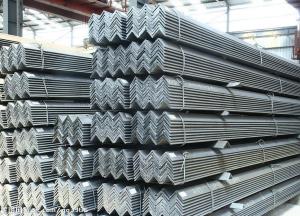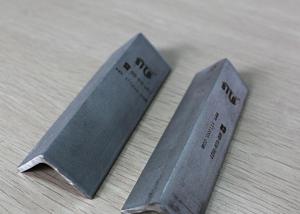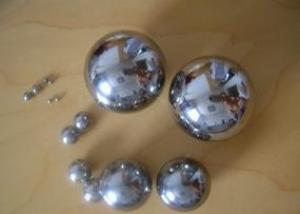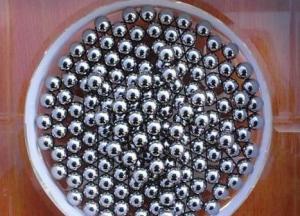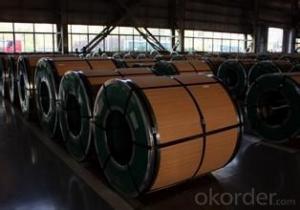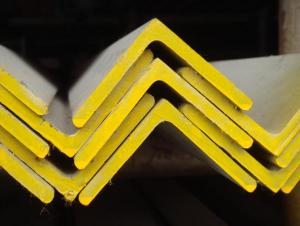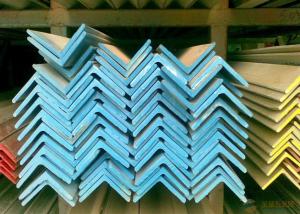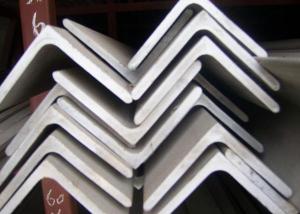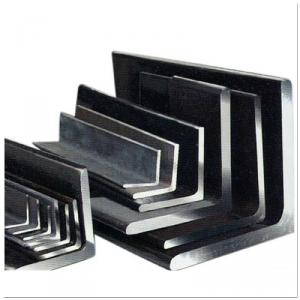Best Quality for Stainless Steel Angles
- Loading Port:
- China Main Port
- Payment Terms:
- TT or LC
- Min Order Qty:
- 1 Ton m.t.
- Supply Capability:
- 2000 Tons Per Month m.t./month
OKorder Service Pledge
OKorder Financial Service
You Might Also Like
Stainless Steel Angles
General Information of Stainless Steel Angles
1. Grade: SS200,300,400 series
2. Size: 25×25×3 mm-100×100×10mm
3. Process: HRAP
4. Length: 2-6m
5. Shape: Equal
6. Delivery: within 20 days
7. MOQ: 1 ton
8. Certificate: ISO 9001:2008, SGS
9. Package: Standard Export Packing, or put into wooden boxes according to your requirement
10. Application: Construction, Marine, Industry and so on.
Specification of Stainless Steel Angles
Name | Stainless Steel Angles | |||||
Standard | ASTM A554, A312, A249, A269 and A270 | |||||
Material Grade | 304,316,201,202, 316L,430 | |||||
Length | 6m or as customers' request | |||||
Tolerance | a) thickness: +/-0. 15mm | |||||
b) Length:+/-4. 5mm - 0mm | ||||||
Surface | 180G, 320G, 400G Satin / Hairline(Matt Finish, Brush, Dull Finish) 400G, 500G, 600G or 800G Mirror finish | |||||
Application | Decoration construction, upholstery, industry instruments | |||||
Test | Squash test, Extended test, Water pressure test, Crystal rot test, Heat treatment, NDT | |||||
Chemical Composition of Material | Composition Material | 201 | 202 | 304 | 316L | 430 |
C | ≤0.15 | ≤0.15 | ≤0.08 | ≤0.08 | ≤0.12 | |
Si | ≤1.00 | ≤1.00 | ≤1.00 | ≤1.00 | ≤1.00 | |
Mn | 5.5-7.5 | 7.5-10 | ≤2.00 | ≤2.00 | ≤1.00 | |
P | ≤0.06 | ≤0.06 | ≤0.045 | ≤0.045 | ≤0.040 | |
S | ≤0.03 | ≤0.03 | ≤0.030 | ≤0.030 | ≤0.030 | |
Cr | 16-18 | 17-19 | 18-20 | 16-18 | 16-18 | |
Ni | 3.5-5.5 | 4-6 | 8-10.5 | 10-14 | ||
Mo | 2.0-3.0 | |||||
Mechanical Property | Material Item | 201 | 202 | 304 | 316L | |
Tensile Strength | ≥535 | ≥520 | ≥520 | ≥520 | ||
Yield Strength | ≥245 | ≥205 | ≥205 | ≥205 | ||
Extension | ≥30% | ≥30% | ≥35% | ≥35% | ||
Hardness (HV) | <253 | <253 | <200 | <200 | ||
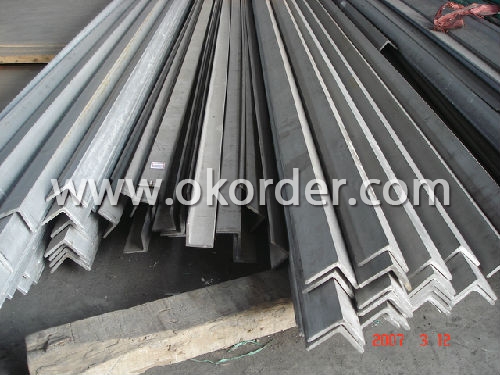
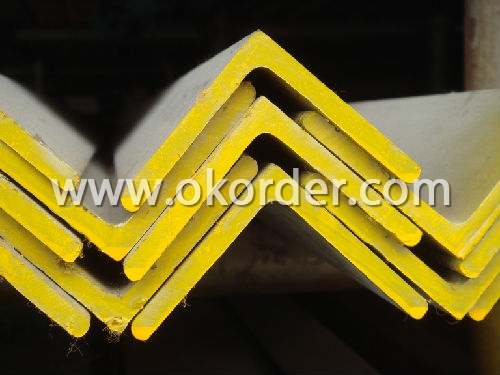
- Q:What are the different methods of cleaning and maintaining stainless steel angles?
- There are several different methods that can be used to clean and maintain stainless steel angles. One common method is to use a mild detergent or soap and water solution. This can be applied using a soft cloth or sponge, and then rinsed thoroughly with water. It is important to avoid using abrasive cleaners or scrub brushes, as these can scratch the surface of the stainless steel. Another method is to use a vinegar and water solution. This can help to remove any stubborn stains or residues on the stainless steel. Simply mix equal parts vinegar and water, apply it to the surface with a cloth, and then rinse with water. For more stubborn stains or discoloration, a stainless steel cleaner or polish can be used. These products are specifically designed to clean and restore the shine of stainless steel. Apply the cleaner or polish according to the manufacturer's instructions, and then buff the surface with a soft cloth to bring back the shine. In addition to regular cleaning, it is also important to regularly maintain stainless steel angles to prevent rust or corrosion. To do this, it is recommended to wipe down the surface with a clean, dry cloth after each use to remove any moisture. Avoid leaving standing water or wet items on the stainless steel for extended periods of time, as this can lead to corrosion. Overall, regular cleaning and maintenance of stainless steel angles will help to keep them looking their best and prolong their lifespan. By using the appropriate cleaning methods and avoiding harsh cleaners or abrasive tools, you can ensure that your stainless steel angles remain in great condition for years to come.
- Q:How does stainless steel angle perform in high-pressure applications?
- Stainless steel angle is renowned for its remarkable strength, durability, and corrosion resistance, making it an optimal choice for high-pressure situations. Its unique composition of chromium, nickel, and other alloys enables stainless steel angle to withstand substantial pressure without distorting or failing. The material's exceptional tensile strength and resistance to stress and creep make it exceedingly dependable in environments with heightened pressures. Furthermore, stainless steel angle retains its structural integrity even in extreme temperatures, rendering it suitable for applications that involve both high pressure and high temperature conditions. It also exhibits resistance to chemical corrosion, which is critical in environments where the material comes into contact with diverse substances. When employed in high-pressure scenarios, stainless steel angle guarantees the safety and longevity of structures or equipment. Its sturdiness and capacity to endure hefty loads and intense pressure prevent any potential leaks or failures, thereby diminishing the risk of accidents or harm to the surrounding environment. In conclusion, stainless steel angle is a reliable and highly effective material for high-pressure applications due to its strength, durability, corrosion resistance, and ability to maintain its structural integrity even in extreme conditions.
- Q:Are stainless steel angles suitable for decorative purposes?
- Yes, stainless steel angles are suitable for decorative purposes. Their sleek and modern appearance, combined with their durability and resistance to corrosion, make them an excellent choice for adding a touch of elegance to any space. Additionally, stainless steel angles can be easily shaped and formed to create various decorative designs, making them versatile for a wide range of applications.
- Q:How do stainless steel angles contribute to energy efficiency?
- Various applications benefit from the significant role played by stainless steel angles in enhancing energy efficiency. The exceptional heat resistance properties of stainless steel allow it to withstand high temperatures without warping or deforming, making it particularly advantageous for energy-intensive industries such as manufacturing and construction. In these sectors, stainless steel angles are utilized to fabricate energy-efficient equipment and structures. Additionally, the high corrosion resistance of stainless steel angles ensures their longevity and reduces the need for frequent replacements. This longevity leads to energy savings by minimizing the production, transportation, and installation of new angles, thus reducing overall energy consumption and carbon emissions associated with manufacturing processes. Recyclability is another way in which stainless steel angles contribute to energy efficiency. Stainless steel is globally recognized as one of the most recycled materials, displaying a high recycling rate. Through the use of stainless steel angles, we can promote a circular economy, where the material can be repeatedly recycled and repurposed, lessening the demand for raw materials and the energy-intensive extraction and production processes linked to them. Moreover, stainless steel angles possess aesthetic properties that can enhance energy efficiency in architectural applications. The reflective surface of stainless steel aids in increasing natural light within buildings, consequently reducing the need for artificial lighting during daylight hours. This utilization of natural light not only saves energy but also contributes to the well-being and productivity of occupants. In conclusion, the heat resistance, corrosion resistance, recyclability, and aesthetic properties of stainless steel angles contribute to energy efficiency. By incorporating stainless steel angles into various applications, we can minimize energy consumption, decrease carbon emissions, and foster a sustainable and energy-efficient future.
- Q:Can stainless steel angles be customized or fabricated to specific requirements?
- Yes, stainless steel angles can be customized or fabricated to specific requirements. Stainless steel is a versatile material that can be easily manipulated and shaped to fit specific design needs. Fabrication processes such as bending, cutting, welding, and machining can be used to modify the angles to meet the desired specifications. Customization options include altering the angle dimensions, lengths, thicknesses, and finishes. Additionally, stainless steel angles can be drilled, punched, or slotted to accommodate specific installation requirements. This flexibility in customization makes stainless steel angles a popular choice for various applications in industries such as construction, architecture, manufacturing, and engineering.
- Q:Can stainless steel angles be used in transportation infrastructure?
- Transportation infrastructure can indeed utilize stainless steel angles. Stainless steel possesses excellent corrosion resistance, durability, and strength, rendering it suitable for diverse transportation infrastructure applications. Bridges, railway tracks, highways, airports, and other transportation facilities can all incorporate stainless steel angles within their construction. The resistance to corrosion provided by stainless steel angles is a primary advantage for transportation infrastructure. This resistance arises from the presence of chromium within stainless steel, which generates a protective oxide layer on the surface. Consequently, stainless steel angles can withstand rust and corrosion caused by exposure to moisture, chemicals, and extreme weather conditions. By ensuring longevity and durability, this corrosion resistance reduces maintenance costs and enhances safety. Additionally, stainless steel angles offer a high strength-to-weight ratio, making them ideal for structural purposes. They can bear heavy loads and contribute to structural stability, thereby improving the safety and reliability of transportation infrastructure. Moreover, stainless steel angles exhibit exceptional resistance to fire and extreme temperatures, further enhancing their suitability for transportation applications. In addition to their mechanical properties, stainless steel angles possess an aesthetic appeal that plays a crucial role in transportation infrastructure projects. Their appearance can be enhanced through polishing, brushing, or coating, thereby improving the visual appeal of bridges, railings, and other transportation structures. Furthermore, stainless steel qualifies as an environmentally friendly material. Being 100% recyclable, it aligns with sustainability goals in transportation infrastructure projects. Utilizing stainless steel angles promotes a circular economy by reducing the demand for new raw materials and minimizing waste. All in all, stainless steel angles offer a plethora of advantages, rendering them suitable for transportation infrastructure applications. Their corrosion resistance, durability, strength, aesthetic appeal, and environmental benefits make them a viable choice for various applications within this sector.
- Q:What is the price range of stainless steel angles?
- The price range of stainless steel angles can vary depending on the size, grade, and supplier. However, generally, stainless steel angles are priced between $5 to $50 per foot.
- Q:Are stainless steel angles suitable for security gates?
- Indeed, security gates can be effectively constructed using stainless steel angles. Renowned for its robustness, durability, and ability to withstand corrosion, stainless steel is an ideal material for applications demanding heightened security and protection. By providing structural support and reinforcement, stainless steel angles guarantee the stability and longevity of security gates. Furthermore, stainless steel possesses an aesthetic allure and can be conveniently tailored to harmonize with the surrounding environment's design. In summary, stainless steel angles present a dependable and efficient choice for security gates, delivering both functionality and an visually pleasing facade.
- Q:Are stainless steel angles resistant to fire?
- Yes, stainless steel angles are highly resistant to fire. Stainless steel is a non-combustible material with a high melting point, making it suitable for applications where fire resistance is required.
- Q:How do you determine the load-bearing capacity of a stainless steel angle?
- To determine the load-bearing capacity of a stainless steel angle, several factors need to be considered. These include the dimensions and thickness of the angle, the material properties of the stainless steel, and the intended application or use of the angle. Load-bearing capacity can be determined through calculations based on engineering principles, such as analyzing the stress and strain on the angle under specific loads. Additionally, industry standards, codes, and specifications may provide guidelines or testing methods to assess the load-bearing capacity of stainless steel angles.
1. Manufacturer Overview |
|
|---|---|
| Location | Zhejiang, China |
| Year Established | 2010 |
| Annual Output Value | above US$16 million |
| Main Markets | East Asia, Middle East. |
| Company Certifications | |
2. Manufacturer Certificates |
|
|---|---|
| a) Certification Name | |
| Range | |
| Reference | |
| Validity Period | |
3. Manufacturer Capability |
|
|---|---|
| a)Trade Capacity | |
| Nearest Port | Shanghai |
| Export Percentage | |
| No.of Employees in Trade Department | above 10 people |
| Language Spoken: | English, Chinese |
| b)Factory Information | |
| Factory Size: | about 30000 square meter |
| No. of Production Lines | above 7 |
| Contract Manufacturing | OEM Service Offered |
| Product Price Range | Average |
Send your message to us
Best Quality for Stainless Steel Angles
- Loading Port:
- China Main Port
- Payment Terms:
- TT or LC
- Min Order Qty:
- 1 Ton m.t.
- Supply Capability:
- 2000 Tons Per Month m.t./month
OKorder Service Pledge
OKorder Financial Service
Similar products
New products
Hot products
Related keywords
